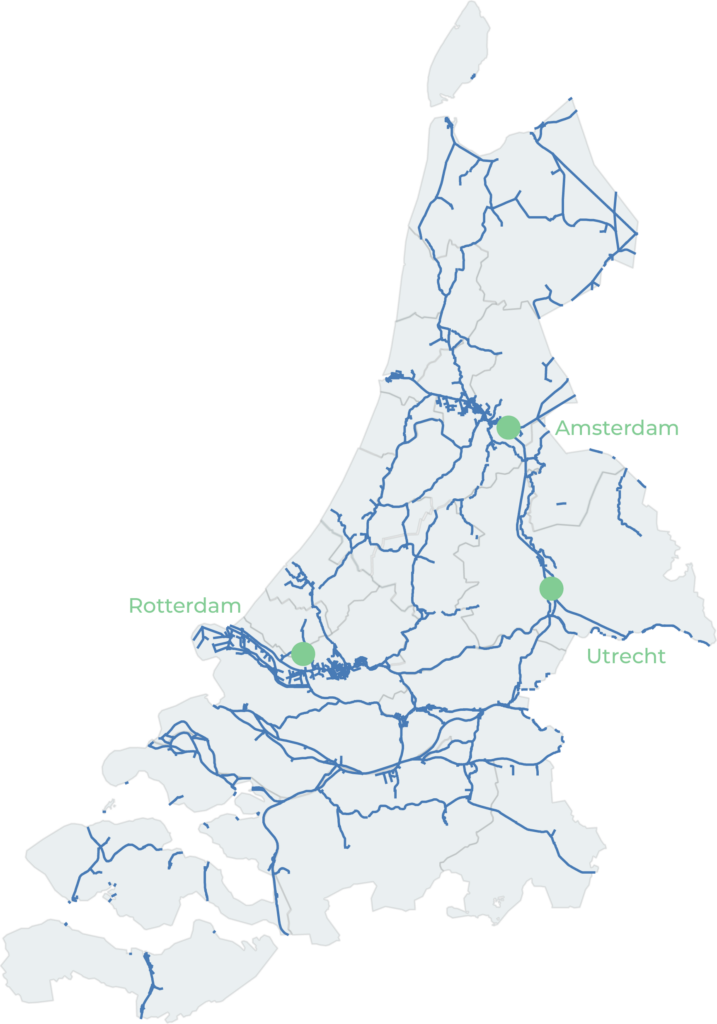Use Case 1 - Netherlands
Use Case 1 focuses on addressing the challenges of congestion and transport efficiency in the densely populated region of The Netherlands, particularly around the cities of Rotterdam, The Hague, Utrecht, and Amsterdam. It further will examine the possibility of the tailored development and establishment of an intermodal transport service mainly footing on inland waterway transport
The area of interest includes metropolitan areas that all together are populated by approximately 8.5 million people. The density in population and economic activity is mirrored by the traffic density as the region accommodates one of the largest European seaports, the busiest airports of Europe, and a large number of highways, railways and inland waterways connecting the different cities and agglomerations with one another. Particularly, road traffic in the area is heavy with the three busiest highways of the entire country (i. e., A13 between Rotterdam and Den Haag, A10 encircling Amsterdam, and A12 from Utrecht to Den Haag). Inland Waterway Transport (IWT) is already established in the use case area. The main waterway connection from Amsterdam via Utrecht and Rotterdam to Hoek van Holland forms a half ring which encloses the core of the Randstad region in its centre and, thus, is considered as the outer ring.
Apart from the large waterways, a set of smaller waterways ranging from CEMT classes I to VI form a regional network, stretching into the cities and urban areas of the Randstad region. These waterways, including domestic waterway corridors connecting Rotterdam and Ijmuiden via Utrecht and Amsterdam (CEMT class VI) or Rotterdam and Amsterdam (CEMT classes II, III, IV, and V).
The objective of UC1 is to establish a multimodal transport system that prioritises the use of inland waterways to carry the heaviest load of cargo, while minimising reliance on road transport. The use case will examine the possibility of an intermodal transport service mainly footing on inland waterway transport for distributing into cities combined with (electric) trucks for short, first- and last-mile transport only in urban areas.

Use Case 2 - Belgium
Use Case 2 area has been defined around a triangle between the Belgian cities Antwerp, Brussels, and Ghent as the region is well-endowed with a set of smaller inland waterways and features good connection to the north (in the direction of Rotterdam and the southern provinces of the Netherlands). The economic activity and the density of logistics services in the Flanders area induce a significant amount of cargo which is already moved on waterways. With cargo passing through the and coming from the areas surrounding Rotterdam, Antwerp and Ghent. Particularly the network of smaller waterways of CEMT classes I to IV is of high interest for AUTOFLEX.
A dense network of existing waterways and smaller distances appears as a promising test field for the zero-emission inland vessel. The expected paradigm shift lies in the significant change of the expected length of a typical voyage. AUTOFLEX focuses on small and automated inland vessels designed for short and medium-sized distances which have not been part of the typical IWT market yet. Shorter distances may allow for a change in propulsion technology, facilitation of battery packs on board the vessel, and the utilisation of an electric drive train.
The objective of Use Case 2 is to enhance the intermodal transport system by integrating renewable energy solutions and ensuring efficient cargo transshipments. Stow & Charge ist envisioned to reliably provide renewable energy while ensuring transshipment interfacing two transport legs. The placement of the Stow & Charge hubs in the region and the development of a network of such hubs are to be examined as part of the research project. Ghent has been selected as the focus point with respect to the blueprint design of a Stow & Charge hub.
UC2 will also delve into the concept of autonomy and its impact on vessel size and design. It will involve evaluating the trade-off between vessel reach and the need for transshipment to smaller vessels or other transport modes.
